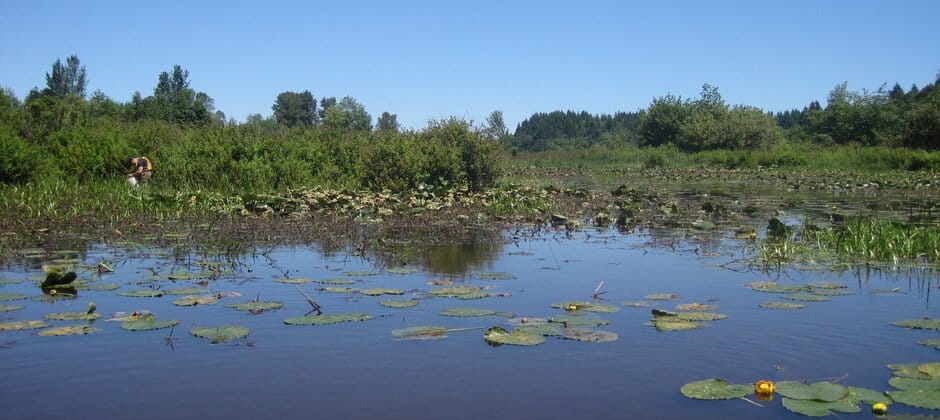Share this article
Native species can tolerate invaders in the lowland floodplains
Invasive bullfrogs and sunfish in the southwestern Washington floodplains don’t seem to be a detriment to native amphibians and fish in the area.
That’s surprising, researchers say, since that isn’t often the case in higher elevation areas, where there are extensive efforts to remove the invasive species.
Research on the topic began when scientists became simultaneously concerned with flooding and declining salmon populations in the Chehalis River floodplain. The region had been dealing with serious flooding issues over the last several decades—one flood in 2007 even shutdown a major thoroughfare between Portland and Seattle. Some people suggested introducing a dam, but conservationists worried this would further exacerbate habitat degradation for salmon. “How do we deal with flooding on the one hand, and an important resource being lost on the other?” said assistant professor of ecology and evolutionary biology at Cornell University Meredith Holgerson.
While salmon were the focus of much research, researchers were also concerned about nonnative bullfrogs (Lithobates catesbeianus) and sunfish (Centrarchus macropterus) that were well-established in the floodplain. Holgerson wondered how these nonnative species were impacting other native wildlife like salamanders, frogs and fish. “Salmon don’t live in a vacuum, and these food webs deserve study,” she said.
Holgerson led a study published in Freshwater Science looking at how the native fauna co-existed with the nonnative species. In previous research, with the Washington Department of Wildlife, she and her colleagues analyzed how different factors influenced species assemblages in over 100 sites across multiple years. “These landscapes are invaded by nonnative bullfrogs and sunfish, but we still see native species do well in some sites,” she said. “How are they hanging on?”
In the more recent research, Holgerson and her team used stable isotope analysis to find out. Isotopic signatures for carbon told them what the nonnative and native species were eating, and isotopic signatures for nitrogen revealed the species’ place in the food chain. “You are what you eat,” Holgerson said.
The analysis involved taking frog and fish samples back to lab, taking out their guts, grinding them to a fine powder and examining them for isotopic signatures.
The research team was pleasantly surprised to find that most of the native species had similar niche sizes in sites with and without nonnatives. That’s good news, Holgerson said, because niche size indicates food resource use. A broader niche allows organisms to use diverse resources, and may buffer from additional threats like climate change.
The long-toed salamander (Ambystoma macrodactylum) was the only species with a smaller niche in the presence of nonnatives. But the other species either had no change in niche size or even an increase in niche size in the presence of the nonnatives.
“These native species are flexible and can tolerate eating different things when the nonnatives are around,” Holgerson said. For example, she said, there’s evidence in the literature that native three-spined stickleback fish (Gasterosteus aculeatus) can feed on either zooplankton or bottom-dwelling invertebrates. They seem to feed more on zooplankton with nonnative sunfish around. “Sunfish like to live on the edge of habitat, so maybe sticklebacks moved to deeper waters and fed more on zooplankton,” she said.
She also found that the northwestern salamander (Ambystoma gracile) fed lower on the food web in the summer, likely eating more bottom-dwelling invertebrates. These food sources were located at pond edges with more emergent vegetation, places where the salamanders likely hide.
In addition, Holgerson didn’t see changes in the salamanders’ body sizes among sites with and without nonnatives, which is promising. Body size is often an indicator of fitness, so similar body sizes suggest the dietary changes did not adversely impact salamander larvae.
Other species like red-legged frogs had minimal dietary shifts. As red-legged frog tadpoles and bullfrogs are both mostly herbivorous, the results indicate algal resources were plentiful. “Maybe the sites we studied are more resilient after an invasion because there’s enough food to go around,” she said.
Overall, Holgerson said the study findings provide good news. “We don’t need to figure out how to remove fish and bullfrogs from a very hydrologically-connected landscape,” she said. However, she said, it is important to manage the habitat for native species. That means having diverse habitat types in ponds and wetlands, including open water as well as edges with shallow slopes and native emergent plants, providing refugia for native species to hide.
Header Image: In the southwestern Washington floodplains, native species seem to tolerate their nonnative counterparts. Credit: Meredith Holgerson








